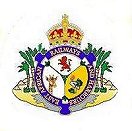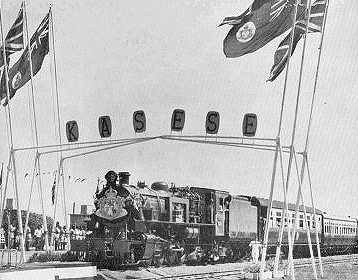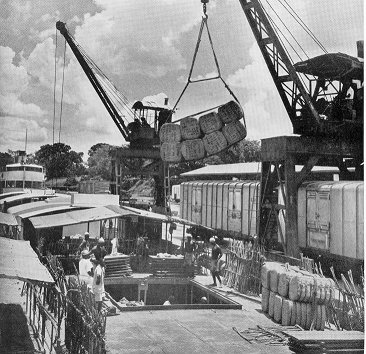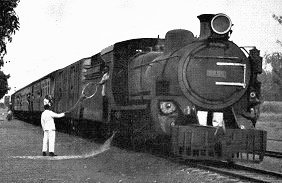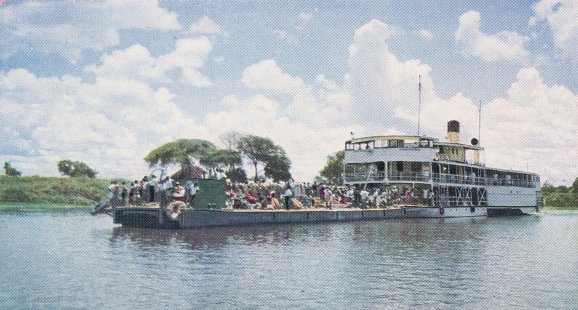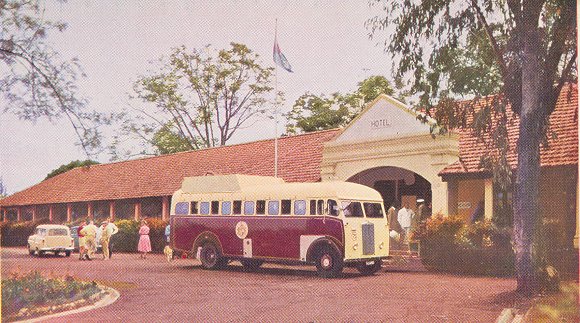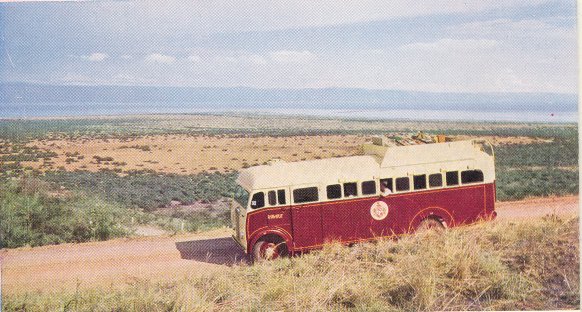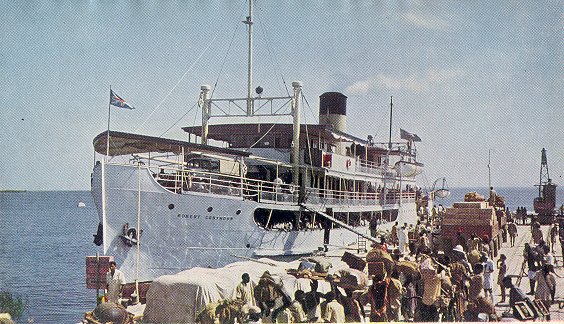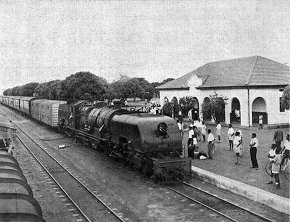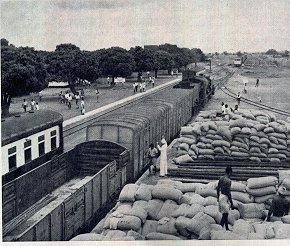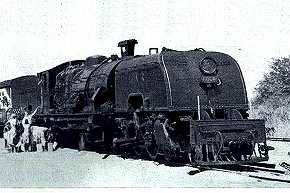|
|
East African Railways and Harbours Western Extension and other Uganda Branch Lines |
|
|||
|
Undoubtedly the most famous of the Uganda "branch" lines, the Western Extension to Kasese took the original concept of the Uganda Railway all the way from the Indian Ocean to the Ruwenzori Mountains. Alas, the line has not survived and trains no longer run to the fabled "Mountains of the Moon". |
|||||
|
|
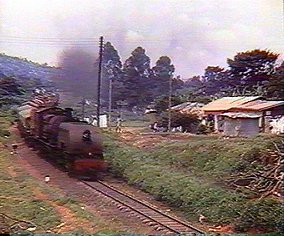 |
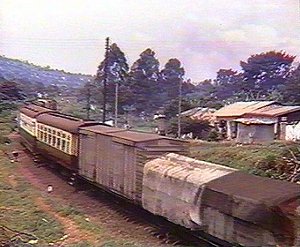 |
|||
| Harry Dodge's sequence of video captures - The African Archives - show a Tribal Class locomotive (left) at Kampala's high level platform which formed part of the station building and was used for passenger trains to the east for Kenya and to the west for Kasese. On Tuesdays, Fridays and Sundays the mixed goods to Kasese conveyed first and second class accommodation and a dining car, but on other days only third class. The train (centre and right) is seen above running through the Kampala suburbs during its evening departure for Kasese. The normal motive power, as here was a 60 Class Garratt. | |||||
|
|
|
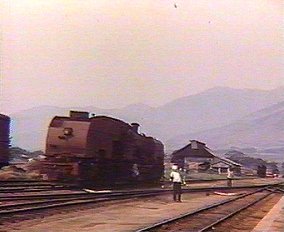 |
|||
| Harry Dodge's sequence continues with the arrival of the all classes all stations mixed goods train arriving at Kasese the following morning. The main purpose of the line was to facilitate the export of copper from the mine at Kilembe There were great plans for Kasese and a grid of tarmac surfaced roads was laid out. But the roads, like the great plans led to nowhere. | |||||
|
|
|
The Ruwenzori Range - the famed Mountains of the Moon - form a backdrop to the 60 Class Garratt as it leaves the train to take on water and head for the small motive power depot where a second Garratt has been stabled. What is a Garratt? A Garratt is an articulated locomotive with two engines - one situated below each the two tenders that carry water and, here, furnace fuel oil (as opposed to coal used in South and Central Africa).. VIDEO SEQUENCE - Harry Dodge - The African Archives |
|||
|
|
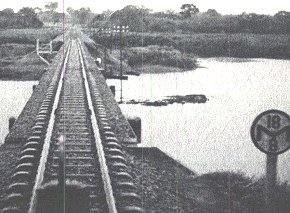 |
||||
| Crossing the Dura River Swamp (above) on the 209 mile Kampala to Kasese line which was opened on 23 November 1956 by the Governor of Uganda, Sir Andrew Cohen - PHOTO Geoffrey Parsons. The sign is a Momentum Board, which refers to the opposing gradient being steeper than the ruling gradient. The figures mean that the driver should achieve a speed of 18 mph at a distance of 4 furlongs (8 half furlongs) from the sign. The train's maximum speed was 25 mph. | |||||
|
The opening of what was officially termed the Western Uganda Extension. A special train conveying the Governor, Sir Andrew Cohen, and HH the Kabaka of Buganda travelled overnight from Kampala behind a 30 Class locomotive which was named Batoro by the Omukama of Toro on its arrival at Kasese . The train is seen arriving at Kasese - the "defaced" blue ensigns are the official flags of the East African Railways and Harbours. The second coach back from the locomotive is a special vehicle which may have formed part of the "royal" train stock used by visiting royals and colonial governors of the time. PHOTOs - EAR&H Magazine, December 1956 |
|||||
|
Mbulamuti to Namasagali - Masindi Port, Masindi and Butiaba |
|||||
| Until the early sixties the main line from Jinja ran to Tororo via Mbulamuti which was the Junction for Namasagali. At one time it had been possible to travel in a through first class coach from Nairobi to Namasagali, the coach being detached at Mbulamuti and added to the 3rd Class service which ran from Jinja to Namasagali. By 1962 there is no mention of this service in the timetable, nor of sailings between Namasagali and Masindi Port. | |||||
|
|
|
||||
|
24 Class heads a mixed
passenger-freight train into Kakira (above) PHOTO - EAR&H Magazine -
on Uganda's oldest section of railway line which ran between Jinja and
Namasagali and was laid long before the extension of the main line from
Kenya. Loading cotton (left) at Namasagali which was the railhead from where steamers departed for Masindi Port - see below - PHOTOs EAR&H 1955-6 Magazines |
|||||
|
|
|||||
|
The Paddle Steamer Lugard 2 propels a barge on the Albert Nile from Namasagli to Masindi Port. PHOTOs EAR&H 1955-6 Magazines |
|||||
|
|
|||||
|
|
|||||
|
From Masindi Port passengers were conveyed by bus on a one and a half hour journey to Masindi Town where, on Wednesdays, there was a half hour break at the hotel before passengers again boarded the bus for Butiaba on Lake Albert. The trip to Butiaba took a further two and a half hours. The return working from Butiaba to Masindi Port occured on Mondays. By September 1962 services between Masindi Port and Namasagali seemed to have been suspended due to flooding on Lake Albert and the River Nile. - PHOTOs EAR&H 1955-6 Magazines |
|||||
|
|
|||||
|
The Steam Ship Robert Coryndon arrives at Butiaba on Lake Albert from where in 1962 it was still operating a service to Pakwach. PHOTO EAR&H 1955-6 Magazines |
|||||
| Tororo to Soroti and Lira | |||||
|
|
|
||||
|
Soroti Station was on the branch from Tororo to Lira via Gulu. A 60 Class arrives with a passenger train (left). Busy time in the yard at Soroti while 60 a Class appears to be mustering its mixed passenger freight train (right) - PHOTOs EAR&H Magazine |
|||||
|
|
A 60 Class with a passenger
train at Bukidea, 58 miles from Tororo and 42 miles from Soroti. The
train was booked to take four and a half hours from Tororo to Soroti where
it was scheduled to arrive at 1205 before continuing on to Lira at
1400. The booked time to Lira was 4 hours 40 minutes. No first class accommodation was available and the trains were scheduled to connect with the daily 2nd and 3rd Class only train between Eldoret and Kampala and vice versa. PHOTO EAR&H Magazine |
||||
